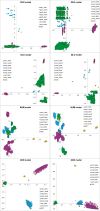Optimization of the standard genetic code according to three codon positions using an evolutionary algorithm
- PMID: 30092017
- PMCID: PMC6084934
- DOI: 10.1371/journal.pone.0201715
Optimization of the standard genetic code according to three codon positions using an evolutionary algorithm
Erratum in
-
Correction: Optimization of the standard genetic code according to three codon positions using an evolutionary algorithm.PLoS One. 2018 Oct 4;13(10):e0205450. doi: 10.1371/journal.pone.0205450. eCollection 2018. PLoS One. 2018. PMID: 30286199 Free PMC article.
Abstract
Many biological systems are typically examined from the point of view of adaptation to certain conditions or requirements. One such system is the standard genetic code (SGC), which generally minimizes the cost of amino acid replacements resulting from mutations or mistranslations. However, no full consensus has been reached on the factors that caused the evolution of this feature. One of the hypotheses suggests that code optimality was directly selected as an advantage to preserve information about encoded proteins. An important feature that should be considered when studying the SGC is the different roles of the three codon positions. Therefore, we investigated the robustness of this code regarding the cost of amino acid replacements resulting from substitutions in these positions separately and the sum of these costs. We applied a modified evolutionary algorithm and included four models of the genetic code assuming various restrictions on its structure. The SGC was compared both with the codes that minimize the objective function and those that maximize it. This approach allowed us to place the SGC in the global space of possible codes, which is a more appropriate and unbiased comparison than that with randomly generated codes because they are characterized by relatively uniform amino acid assignments to codons. The SGC appeared to be well optimized at the global scale, but its individual positions were not fully optimized because there were codes that were optimized for only one codon position and simultaneously outperformed the SGC at the other positions. We also found that different code structures may lead to the same optimality and that random codes can show a tendency to minimize costs under some of the genetic code models. Our results suggest that the optimality of SGC could be a by-product of other processes.
Conflict of interest statement
The authors have declared that no competing interests exist.
Figures











Similar articles
-
The optimality of the standard genetic code assessed by an eight-objective evolutionary algorithm.BMC Evol Biol. 2018 Dec 13;18(1):192. doi: 10.1186/s12862-018-1304-0. BMC Evol Biol. 2018. PMID: 30545289 Free PMC article.
-
Optimality in the standard genetic code is robust with respect to comparison code sets.Biosystems. 2019 Nov;185:104023. doi: 10.1016/j.biosystems.2019.104023. Epub 2019 Sep 11. Biosystems. 2019. PMID: 31520875
-
Optimization of the standard genetic code in terms of two mutation types: Point mutations and frameshifts.Biosystems. 2019 Jul;181:44-50. doi: 10.1016/j.biosystems.2019.04.012. Epub 2019 Apr 28. Biosystems. 2019. PMID: 31042561
-
Generation of genetic codes with 2-adic codon algebra and adaptive dynamics.Biosystems. 2024 Jun;240:105230. doi: 10.1016/j.biosystems.2024.105230. Epub 2024 May 11. Biosystems. 2024. PMID: 38740125 Review.
-
Evolution and multilevel optimization of the genetic code.Genome Res. 2007 Apr;17(4):401-4. doi: 10.1101/gr.6144007. Epub 2007 Mar 9. Genome Res. 2007. PMID: 17351130 Review.
Cited by
-
Model of Genetic Code Structure Evolution under Various Types of Codon Reading.Int J Mol Sci. 2022 Feb 1;23(3):1690. doi: 10.3390/ijms23031690. Int J Mol Sci. 2022. PMID: 35163612 Free PMC article.
-
Correction: Optimization of the standard genetic code according to three codon positions using an evolutionary algorithm.PLoS One. 2018 Oct 4;13(10):e0205450. doi: 10.1371/journal.pone.0205450. eCollection 2018. PLoS One. 2018. PMID: 30286199 Free PMC article.
-
Some theoretical aspects of reprogramming the standard genetic code.Genetics. 2021 May 17;218(1):iyab040. doi: 10.1093/genetics/iyab040. Genetics. 2021. PMID: 33711098 Free PMC article.
-
Evolution of Life on Earth: tRNA, Aminoacyl-tRNA Synthetases and the Genetic Code.Life (Basel). 2020 Mar 2;10(3):21. doi: 10.3390/life10030021. Life (Basel). 2020. PMID: 32131473 Free PMC article. Review.
-
Self-similarity and the maximum entropy principle in the genetic code.Theory Biosci. 2023 Sep;142(3):205-210. doi: 10.1007/s12064-023-00396-y. Epub 2023 Jul 4. Theory Biosci. 2023. PMID: 37402087
References
-
- Schönauer S, Clote P. How optimal is the genetic code? In: Frishman D, Mewes HW, editors. Computer Science and Biology Proceedings of the German Conference on Bioinformatics (GCB'97) Sep 21–241997. p. 65–7.
-
- Crick FH. The origin of the genetic code. Journal of molecular biology. 1968;38(3):367–79. Epub 1968/12/01. . - PubMed
-
- Khorana HG, Buchi H, Ghosh H, Gupta N, Jacob TM, Kossel H, et al. Polynucleotide synthesis and the genetic code. Cold Spring Harbor symposia on quantitative biology. 1966;31:39–49. Epub 1966/01/01. . - PubMed
-
- Nirenberg M, Caskey T, Marshall R, Brimacombe R, Kellogg D, Doctor B, et al. The RNA code and protein synthesis. Cold Spring Harbor symposia on quantitative biology. 1966;31:11–24. Epub 1966/01/01. . - PubMed
-
- Sonneborn TM. Degeneracy of the genetic code: extent, nature, and genetic implications In: Bryson V, Vogel HJ, editors. Evolving genes and proteins. New York: Academic Press; 1965. p. 377–97.
Publication types
MeSH terms
Substances
LinkOut - more resources
Full Text Sources
Other Literature Sources

